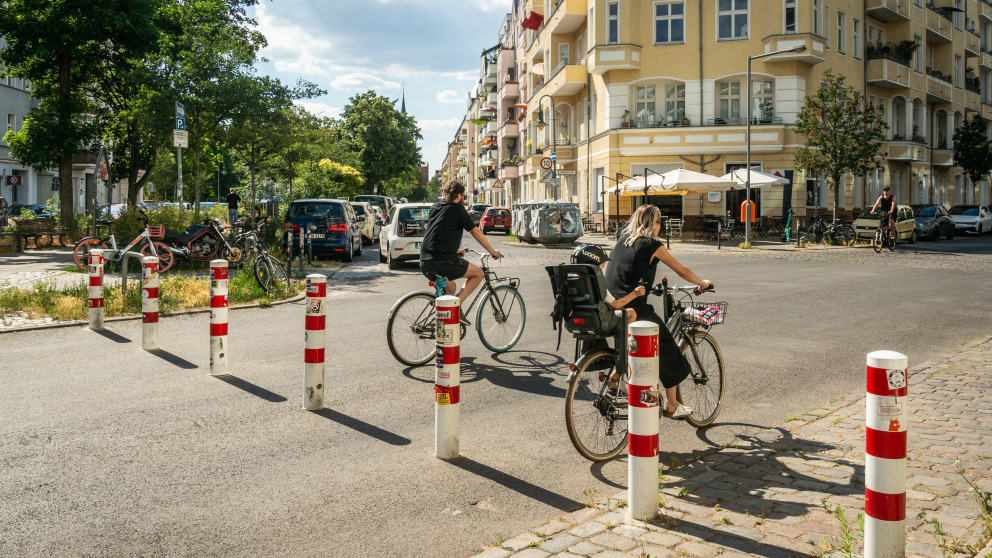Streets Ahead With Superblocks: What Berlin Can Learn From the Rest of Europe
21.06.2023

Studies abroad have shown that so-called “superblocks” reduce through traffic, encourage cycling and promote the use of public transport services.
Neighbourhoods across Berlin are embracing the superblock concept. Residents have petitioned local authorities to establish superblocks (known locally as Kiezblocks) in their neighbourhoods, pushing the topic onto the agenda in assemblies across the city’s twelve boroughs, most recently in Tempelhof-Schöneberg. So far, assemblies in five boroughs have voted to establish at least 16 superblocks in response to applications by residents.
Motions to establish a further eight superblocks have also passed in borough assemblies. But the debates that accompanied these motions also revealed concerns. It’s hardly surprising that the idea of banning through traffic is unsettling for some, not least of all because Berlin has yet to see the concept actually put into practice…
Berlin can learn from other cities
The good news is: We can draw on the experiences of several European cities that have implemented similar approaches. The European research project “TuneOurBlock” is monitoring the effects of these measures, supported by scientists at the Research Institute for Sustainability (RIFS) in Potsdam and the German Institute of Urban Affairs (DIFU) in Berlin. The evidence already available offers answers to many of the questions that keep coming up in the debate.
But let’s take a closer look at the concept: The basic idea of a superblock is to ban motorized through traffic within a designated area – except for buses and emergency vehicles. Residents can still access their neighbourhood by car – driving in and out of the neighbourhood is not a problem – it is simply no longer possible to drive through it to access major roads (also known as “boundary roads”) on the other side. Superblocks can also include smaller pedestrian zones, public squares, or green spaces. Most of the submissions made to assemblies in Berlin focus on eliminating through traffic from neighbourhoods.
Isn’t traffic simply displaced to surrounding streets?
One question that often comes up, is whether superblocks merely benefits residents by displacing motorized traffic to surrounding streets. This assumes that motorized traffic volumes are constant or growing. But planners can influence this through the design of transport infrastructure. Research conducted at RIFS, for example, showed that the creation of "pop-up bike lanes" led to a surge in bicycle traffic in Berlin. Similar trends have been in observed in other cities that established dedicated bike lanes.
By making it more attractive to use public transport services or to walk or cycle, superblocks encourage people to turn their backs on motorized modes. Fears that traffic would simply be displaced have proved largely unfounded. A study published in 2022 of superblocks in Barcelona showed that motorized traffic fell by around 15 percent in the affected areas. The study also revealed changes in traffic volumes in surrounding streets, with traffic decreasing in some cases and increased slightly (by two percent) in others.
Research has also been conducted on the impacts of “low traffic neighbourhoods” (LTNs) in London. A recent study that examined 46 LTNs revealed an average 47 percent drop in motorized traffic within Low Traffic Neighbourhoods, accompanied by an increase in traffic on boundary roads of less than one percent.
A study carried out by Imperial College London in conjunction with the London School of Economics found that motorized traffic declined by almost 60 percent within LTNs in London. Traffic on boundary roads also dropped, the study showed, but only by 13 percent. The researchers also noted a reduction in nitrogen dioxides, with improvements in air quality on boundary roads actually exceeding those recorded within LTNs. These results are consistent with air quality measurements gathered in other contexts, such as restrictions on motorized traffic in downtown Madrid, where a drop in nitrogen dioxide emissions within the area covered by traffic calming measures did not affect concentrations outside the area.
More and more road users ditch cars
A study of the effects of implementing low traffic neighbourhoods in London revealed that the impacts snowball as people scale back their use of cars and increasingly opt to walk or cycle. Some choose to part with their cars altogether after one or two years. At a conference on superblocks and similar measures, representatives from Ghent (Belgium) also reported a fall in the car ownership rate following the establishment of a ring of superblocks around the car-free inner-city precinct in 2017. Overall, car ownership dropped from 1.2 cars per household in 2015 to 1.0 cars in 2021. All this suggests that superblocks contribute to a reduction in motor vehicle traffic, even on main streets, over the longer term.
Fewer accidents, better air
Research also shows that superblocks boost road safety. A study of the benefits achieved in London reveals a significant drop in the number of road traffic injuries in low traffic neighbourhoods, with no notable changes in the number of accidents on main roads.
Experience suggests that superblocks and similar traffic calming measures do not displace the harms associated with motorized transport to boundary roads. On the contrary, air quality tends to improve on these roads. Research also shows that traffic safety remains relatively constant on main roads – and may even improve over the medium term – so that residents also benefit from nearby superblocks. These observations refute the concern often raised in local assemblies that superblocks cause boundary roads to become more congested.
Superblocks are not a panacea for the myriad problems facing many cities. But they are a good, fast, and inexpensive part of the solution and one that will not disadvantage residents on nearby streets. The debate should focus on how we can harness their benefits quickly and fairly.
This post was first published on 13 June 2023 in the German daily newspaper Der Tagesspiegel.
